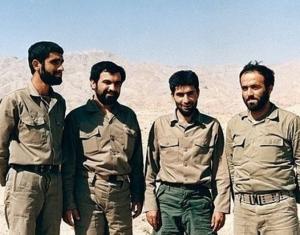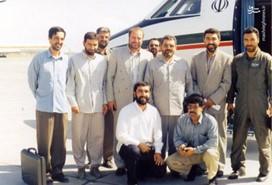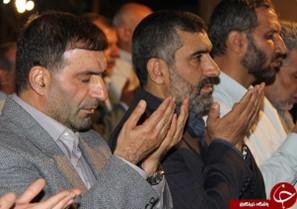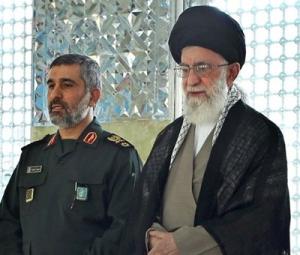Amir Ali Hajizadeh: Commander of the IRGC’s Aerospace Force
Download PDFPage Navigation
As commander of the Islamic Revolutionary Guard Corps’ Aerospace Force (IRGC-AF), Amir Ali Hajizadeh plays a critical role in the development, proliferation, and use of Iran’s drone and missile programs. Since the death of Qassem Soleimani, the late commander of the IRGC’s Quds Force, Hajizadeh has presided over a more active and assertive IRGC-AF. The longevity of his tenure is a sign of the confidence that Iran’s Supreme Leader, Ayatollah Ali Khamenei, has in his abilities.
Amir Ali Hajizadeh’s Career
 Photo of Amir Ali Hajizadeh (L) with Hassan Tehrani Moghaddam (second from right)
Photo of Amir Ali Hajizadeh (L) with Hassan Tehrani Moghaddam (second from right)
The career of Hajizadeh, despite being one of the most prominent commanders in the IRGC’s top brass, remains shadowy. Different sources place his birth year as either 1961 or 1962 in Tehran. His parents originally hailed from Karaj, and he has a master’s degree in management. After the Islamic Revolution of 1979 and the outbreak of the Iran-Iraq War, Hajizadeh soon joined the IRGC as a sniper and was affiliated with its artillery division. Some accounts place him as the chief of the IRGC’s artillery division and the deputy commander of ground-to-ground missiles during the war. During this time, Hajizadeh met a man who would change the course of his life—Hassan Tehrani Moghaddam. As a source told Middle East Eye, “when Moghaddam and 12 other people went on a three month mission to Damascus in 1984 to be trained by the Syrian army to launch the Scud B missiles Iran had received from Libya, he proposed to the top commanders that Hajizadeh organize the first missile unit—named ‘Hadid’—before he returned to Syria to command the unit himself.” Moghaddam became the commander of the IRGC’s missile program in 1983 and spearheaded the development of the Shahab missile, which can deliver nuclear warheads and reach Israel. Hajizadeh being a protégé of Moghaddam served him well given Moghaddam’s proximity to Khamenei, who, according to The New York Times, had a security detail in the Islamic Republic that was one of the strictest and supervised by the supreme leader himself.
As recounted in a history by IranWire, the IRGC-AF was founded in September 1985 as the IRGC’s Air Force. It began work ferrying government officials around Iran and did not have a combat role during the Iran-Iraq War. During this time, in 1986, Hajizadeh reportedly visited North Korea as a part of an IRGC delegation to acquire missile technology. It was not until 1989, which coincided with the elevation of Khamenei as supreme leader, that the IRGC’s Air Force developed a military division and missile bases around Iran, and started using fighter jets from Iran’s Army (Artesh), one of its two militaries. The IRGC is the other.
During this growth period, in 2002, Hajizadeh reportedly signed a contract involving the construction of a covert, underground nuclear facility at Parchin. His possible affiliation with this project was noteworthy given his skillsets in the delivery systems of nuclear weapons-capable missiles and association with Moghaddam, who focused work on satellite launch vehicles and solid-propellants. This is consistent with accounts that place Hajizadeh as an engineering and reconstruction base commander for the IRGC Air Force at the time.
 Photo of Hassan Tehrani Moghaddam (second from left); Mohammad Bagher Ghalibaf (center); and Amir Ali Hajizadeh (seated on the left). Ghalibaf and Hajizadeh served as commanders of the IRGC-AF.
Photo of Hassan Tehrani Moghaddam (second from left); Mohammad Bagher Ghalibaf (center); and Amir Ali Hajizadeh (seated on the left). Ghalibaf and Hajizadeh served as commanders of the IRGC-AF.
Hajizadeh rose through the IRGC’s Air Force ranks over the tenures of seven of its commanders. In the mid-2000s, Hajizadeh was named the IRGC’s Air Defense commander. In 2005, Moghaddam was named deputy commander of the IRGC’s Air Force. Hajizadeh later recounted in an interview that the then commander-in-chief of the IRGC at one point wanted to name Moghaddam as commander, but he declined. Hajizadeh would eventually become commander himself in 2009, while Moghaddam, his patron during the early part of his career, was nominally his deputy.
 Photo of Hassan Tehrani Moghaddam (L) with Amir Ali Hajizadeh (R)
Photo of Hassan Tehrani Moghaddam (L) with Amir Ali Hajizadeh (R)
Hajizadeh took over the IRGC during a period of restructuring. In 2009, the supreme leader reorganized the IRGC’s Air Force into the IRGC’s Aerospace Force, which incorporated a serious space program whose focus included the development of satellite launch vehicles that incorporate technology relevant to the development of ballistic missiles, including longer-range systems. Upon taking the helm of the IRGC-AF, Hajizadeh’s career was broadly consistent with some of his predecessors, especially Hossein Dehghan, who had also risen from deputy commander to commander in the 1980s and early 1990s. Others had more senior-level experience as cabinet ministers—like Mohammad Hossein Jalali, who was defense minister before the commandership of the IRGC’s Air Force.
Hajizadeh later recounted his first meeting with Iran’s supreme leader. He said, “at that point, I had a background of 25 years experience in the missile field…I had prepared an extensive plan for myself. I also presented a written version of it to the supreme leader. When I went to the supreme leader, I told him I want to do these projects and these projects. I told him with a lot of excitement, activity, and motivation that I really want to do these projects. The supreme leader said one sentence to me: ‘the work you want to do is not my priority. I want precision from you.” This was a nod to Khamenei’s priority of developing precision-guided munitions for transfer to Iran’s expansive network of terrorist proxies and partners like Hezbollah.
Setbacks occurred early in Hajizadeh’s tenure at the Aerospace Force. In October 2010, an explosion took place at an IRGC missile base near Khorramabad. A year later, in November 2011, a blast happened at another military base near Bidganeh, which killed Hassan Tehrani Moghaddam, Hajizadeh’s close associate. Such operations are thought to be sabotage attempts by Israel. As the Guardian noted at the time, “the bases in both cases housed Iran’s Shahab-3 missiles, based on a North Korean design. An upgraded variant was said to have a range of 1,200 miles, which would allow it to reach Israel. A report last week by the International Atomic Energy Agency (IAEA) said its inspectors had found evidence that Iran had carried out research and tests on making a nuclear warhead small enough to put on top of a Shahab-3.”
Moghaddam was hailed at his funeral as “the main architect of the Revolutionary Guards’ cannon and missile power and the founder of the deterrent power of our country,” according to the then deputy commander-in-chief of the IRGC. This explains the sensitivity of the work taking place in these two locations and the magnitude of the loss.
Throughout his tenure, Hajizadeh has always been ready with hair-raising commentary boasting about Iran’s missile power and threatening enemies. In 2009, he proclaimed, “be sure that in case of any aggression, the Zionists’ F15 and F16 aircrafts will be trapped by our air defense and will be destroyed. And if one of their aircraft manages to escape Iran’s air defense—before it can land—the bases from which these aircraft have taken off will be struck by our destructive ground-to-ground missiles.” In July 2011, Hajizadeh warned that “there are 50 American bases surrounding Iran, no more than 200-300 kilometers away. If the Americans want to carry out evil deeds against us—well, they have brought 150,000 soldiers over, and they have dozens of bases. We can bomb all these targets, including the U.S. Navy, in the Persian Gulf. This will happen if the U.S. wants to carry out a criminal operation against us, and the same goes for Israel.” A former commander of U.S. Central Command, Kenneth F. McKenzie, called Hajizadeh “reckless.”
Hajizadeh has also been a reliable bragger on behalf of the Islamic Republic as to its military technological achievements. In 2022, he stated the IRGC could fly 60 UAVs (drones) at a time and that the firepower of missiles has increased more than 6 to 7 times, and the preparation time for firing has been reduced. That same year he claimed Iran had developed a hypersonic ballistic missile “to counter air defense shields. It will be able to breach all the systems of anti-missile defense. The missile, which targets enemy anti-missile systems, represents a great generational leap in the field of missiles.” U.S. officials doubt Iran has actually developed such a missile. Still, there are growing concerns over Russia providing it with the technology to do so as a payback for providing drones for its invasion of Ukraine. In fact, when the European Union sanctioned Hajizadeh in 2022, it noted that he “is responsible for UAV-related defense cooperation, including the supply of UAVs to the Russian Federation for their use in the war of aggression against Ukraine.” Hajizadeh is also under sanctions in the United States, including a counterterrorism designation.
Hajizadeh may be supportive of increasing the range of Iran’s missile program. The program is currently limited to a range of 2000 kilometers. But he has threatened publicly that “we have the ability to build missiles with a broader range. We don’t have limitations from a technical perspective or by conventions with regard to missile range.” It is limited to 2000 kilometers because of a political decision by Iran’s supreme leader, who has rejected requests for increases, including to 5000 kilometers. Nevertheless, senior military officers have publicly expressed a desire to expand the range.
Iran’s drone program does not appear to be subject to that same limitation, with IRGC commanders boasting of drones with a range of 7000 kilometers. As Hajizadeh recounted in 2020, “four or three years ago, in a meeting we had with the supreme leader about the UAVs, he said that the performance is very good, but the number of UAVs is low and you should increase it. After this, we all mobilized to increase the number of UAVs.” This shows that the drone program has become increasingly valuable for Iran’s decision-makers and shapers—especially as an export potential.
Over the years, the IRGC-AF has grown bolder under Hajizadeh’s leadership—leaving behind any shred of plausible deniability and pivoting from rhetorical barbs and technological advancements to greater offensive operations. The IRGC-AF was behind the retaliation against the Islamic State (ISIS) in Deir ez-Zour, Syria, after ISIS forces launched a terrorist attack against Iran’s parliament and the Imam Khomeini mausoleum. In 2019, forces under Hajizadeh’s command downed a U.S. reconnaissance drone over the Persian Gulf. This trend accelerated especially after Qasem Soleimani, the late commander of the IRGC’s Quds Force, died in 2020. Israel’s then-defense minister in 2021 called out Hajizadeh publicly, saying he “is behind dozens of terror attacks in the region employing UAVs and missiles.” He has also been spotted visiting Syria throughout 2019 and 2020.
Under Hajizadeh’s leadership, the IRGC-AF UAV Command has been particularly active, masterminding the July 2021 attack on the Mercer Street, a commercial vessel, off the coast of Oman, killing two European nationals. There have also been repeated strikes by the IRGC targeting Iraqi Kurdistan as the Islamic Republic has sought to deflect from a growing protest movement against its rule. U.S. intelligence has also revealed the IRGC-AF has been active in trying to target Israeli maritime interests in 2023. Additionally, as IntelliTimes has noted, the deputy coordinator of the IRGC-AF, Fereydoun Mohammadi Saghaei, who serves under Hajizadeh, has been personally involved in deploying advanced Iranian air defense systems in Syria and Lebanon, visiting Damascus multiple times. Given this record in terrorism, some Israeli officials consider Hajizadeh to be the new Soleimani, likely because Soleimani’s successor, Esmail Ghaani, lacks his charisma and because of this increasing aggression.
Hajizadeh also played a very public role after the IRGC downed Ukraine International Airlines Flight 752 in January 2020, killing 176 people. Forces under Hajizadeh’s command were responsible for the downing. Hajizadeh himself later told a press conference that IRGC forces were at the highest level of alert and surface-to-air missile units were relocated “to prepare for war” after the IRGC retaliated against U.S. forces in Iraq after the American military killed Soleimani. He recalled, “I was in the west of the country following the completion of missile strikes against the U.S. bases when I heard the heart-wrenching news of the Ukrainian airlines flight crash. When I confirmed what had happened, I really wished I could die myself. I said that I wished I could die to not witness such an event. For a lifetime we have made ourselves ready to die for the people. Today, we are trading our reputation with almighty God and in these very difficult circumstances, I am here before you to explain what happened.” But tellingly, Hajizadeh remained in his post after the downing of the flight, which speaks to the desire to insulate the leadership and the top brass of the IRGC from the fallout. Victims assess that the IRGC purposely kept airspace open in Tehran to use civilian planes as human shields against any prospect of U.S. retaliation over the Iranian strikes against American bases in Iraq.
Future Prospects
 Photo of Amir Ali Hajizadeh (L) and Ayatollah Ali Khamenei (R)
Photo of Amir Ali Hajizadeh (L) and Ayatollah Ali Khamenei (R)
Hajizadeh has been commander of the IRGC-AF since 2009. He is already its longest-serving commander since the 1979 Islamic Revolution. Hajizadeh was installed in the same year as the commander of the IRGC’s Ground Forces, Mohammad Pakpour, and both men have been mainstays in their posts. That is likely a nod to their importance to the supreme leader. Nevertheless, Khamenei may eventually decide to make changes. Hajizadeh’s predecessors have all gone onto important posts in the Islamic Republic—namely as IRGC deputy commander and later commander-in-chief like Hajizadeh’s immediate predecessor Hossein Salami; cabinet posts, as Hossein Deghghan later became defense minister after his service as the commander of the IRGC’s then Air Force; and political offices as Mohammad Bagher Ghalibaf rose to become speaker of parliament. These are all possibilities for Hajizadeh. Alternatively, Khamenei may decide to install him as a military advisor, given his longevity of service and institutional memory.
Until there is a change in command, Hajizadeh will likely continue to raise his profile, with the IRGC-AF undertaking increasingly bold operations on behalf of the Islamic Republic.
Receive Iran News in Your Inbox.
Eye on Iran is a news summary from United Against Nuclear Iran (UANI), a section 501(c)(3) organization. Eye on Iran is available to subscribers on a daily basis or weekly basis.
Receive Iran News in Your Inbox
The Iran nuclear deal is done. And the world's biggest companies have already visited Tehran ready to strike a deal when sanctions end. These businesses will add even more to Iran's bottom line. And that means continued development of nuclear technologies and more cash for Hamas and Hezbollah.